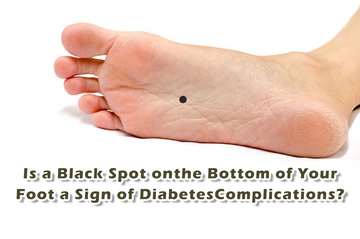Is a Black Spot on the Bottom of Your Foot a Sign of Diabetes Complications?
A black spot on the bottom of your foot can arise from various causes. While it’s not always related to diabetes, it can sometimes signal a diabetic complication. Proper understanding of potential causes and timely medical advice are crucial, especially for those managing diabetes.
Common Causes of Black Spots on the Foot
Black spots may result from multiple factors, including:
1. Subdermal Hematoma (Bruising)
- Minor injuries can cause blood to pool under the skin, creating dark spots. While bruising is common, people with diabetes might experience slower healing due to poor circulation.
2. Plantar Warts
- These are caused by the human papillomavirus (HPV) and often appear as black dots from clotted blood vessels. Though common, individuals with diabetes should monitor plantar warts closely to avoid infections.
3. Diabetic Foot Ulcers
- A black spot could indicate the early stages of a diabetic foot ulcer, particularly if swelling or redness is present. Untreated ulcers can lead to tissue death (gangrene), requiring urgent care.
4. Skin Cancer (Melanoma)
- A dark spot with irregular borders or changes in shape might be a melanoma. Regular foot checks are essential to detect such conditions early.
5. Poor Circulation (Peripheral Artery Disease - PAD)
- Diabetes can lead to PAD, which restricts blood flow to the extremities, causing discoloration or black spots. Explore tips on managing circulation with diabetes-friendly socks.
Signs the Spot May Be a Diabetes Complication
If you have diabetes, monitor for the following symptoms alongside a black spot:
- Persistent wounds that don’t heal.
- Numbness or tingling (a sign of neuropathy).
- Swelling, redness, or discharge (potential infection).
- Cold feet or pale skin (reduced blood flow from PAD).
For proactive care, consider wearing breathable bamboo socks, designed to improve foot health and comfort.
When to See a Doctor
Seek medical attention if the black spot:
- Is painful or growing.
- Changes color or shape.
- Comes with swelling, redness, or discharge.
- Occurs alongside poor circulation symptoms, such as numb or cold feet.
How to Prevent Diabetic Foot Issues
Proper foot care can reduce the risk of complications. Here’s how:
1. Perform Daily Foot Checks
- Inspect your feet for cuts, discoloration, or abnormalities. Learn more about maintaining diabetic foot health.
2. Wear Protective Footwear
- Choose well-fitting shoes and socks. Try GENTLEAGU bamboo socks for breathable, moisture-wicking comfort.
3. Keep Feet Clean and Moisturized
- Wash your feet daily and moisturize to prevent dryness and cracking, but avoid applying lotion between toes to reduce infection risks.
4. Control Blood Sugar Levels
- Stabilized blood sugar reduces the risk of neuropathy and circulation issues. Learn about the connection between diabetes and foot care.
Conclusion
A black spot on the bottom of your foot isn’t always a cause for alarm, but it could indicate a diabetes-related complication like poor circulation or an ulcer. Preventive care, such as wearing high-quality bamboo socks, performing daily foot checks, and consulting a healthcare professional when needed, can protect your foot health. Take action promptly to address any concerning signs and maintain a healthy, active lifestyle.
This optimized content embeds URLs strategically into descriptive and relevant anchor text, improving search engine visibility while guiding users to useful resources.
